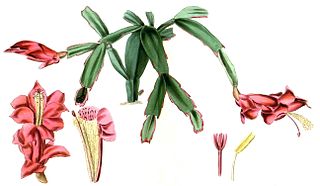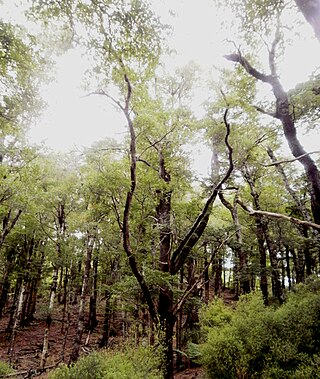
Schlumbergera truncata, the false Christmas cactus, is a species of plant in the family Cactaceae. Because it produces a flower, it also belongs to the taxonomic group Magnoliophyta and is thus considered an angiosperm. It is endemic to a small area of the coastal mountains of south-eastern Brazil where its natural habitats are subtropical or tropical moist forests. It is the parent or one of the parents of the houseplants called Christmas cactus, Thanksgiving cactus or zygocactus, among other names.

Schlumbergera is a small genus of cacti with six to nine species found in the coastal mountains of south-eastern Brazil. These plants grow on trees or rocks in habitats that are generally shady with high humidity, and can be quite different in appearance from their desert-dwelling cousins. Most species of Schlumbergera have stems which resemble leaf-like pads joined one to the other and flowers which appear from areoles at the joints and tips of the stems. Two species have cylindrical stems more similar to other cacti.

Nepenthes truncata is a tropical pitcher plant endemic to the Philippines. It is known from the islands of Dinagat, Leyte, and Mindanao. The species grows at an elevation of 0–1500 m above sea level. Nepenthes truncata is characterised by its heart-shaped (truncate) leaves and very large pitchers, which can reach up to 40 cm in height.
Nepenthes × truncalata is a natural hybrid involving N. alata and N. truncata. Like its two parent species, it is endemic to the Philippines, but limited in distribution by the natural range of N. truncata on Mindanao.

Nothofagus truncata, or hard beech, is a species of tree endemic to New Zealand. Its common name derives from the fact that the timber has a high silica content, making it tough and difficult to saw. Hard beech is a tree up to 30m tall occurring in lowland and lower montane forest from latitude 35°S to 42°30'S, that is, from the north of the North Island southwards to Marlborough and south Westland in the South Island. In Taranaki it forms almost pure stands on the rugged sandstone country there and is partially deciduous, dropping many of its leaves at the end of the winter. N. truncata became known as Fuscospora truncata after 2013 in New Zealand.
Atriplex truncata is a species of saltbush known by the common names wedgeleaf saltbush, wedgescale, and wedge orach, native to western North America from British Columbia to California and to New Mexico. It grows in montane to desert habitats with saline soils, such as dry lake beds.

Mya truncata, common name the blunt gaper or truncate softshell, is a species of edible saltwater clam, a marine bivalve mollusk in the family Myidae.

Roombia truncata is a species of katablepharids, which are heterotrophic single-celled organisms.

Telopea truncata, commonly known as the Tasmanian waratah, is a plant in the family Proteaceae. It is endemic to Tasmania where it is found on moist acidic soils at altitudes of 600 to 1200 m (2000–4000 ft). Telopea truncata is a component of alpine eucalypt forest, rainforest and scrub communities. It grows as a multistemmed shrub to a height of 3 metres (10 ft), or occasionally as a small tree to 10 m (35 ft) high, with red flower heads, known as inflorescences, appearing over the Tasmanian summer and bearing 10 to 35 individual flowers. Yellow-flowered forms are occasionally seen, but do not form a population distinct from the rest of the species.

Lambis truncata, common name the giant spider conch, is a species of sea snail, a marine gastropod mollusc in the family Strombidae, the true conchs.

Haworthia truncata, locally known as horse's teeth, is a species of succulent plant in the genus Haworthia. It is found in the Little Karoo region, in the far east of the Western Cape Province, South Africa.

Nepenthes robcantleyi, or Robert Cantley's pitcher plant, is a tropical pitcher plant endemic to the Philippine island of Mindanao. It is closely allied to N. truncata and was once considered a dark, highland form of this species. Nepenthes veitchii from Borneo is also thought to be a close relative.

Norape is a genus of moths in the family Megalopygidae. The genus was erected by Francis Walker in 1855.
Stesilea is a genus of longhorn beetles of the subfamily Lamiinae, containing the following species:
Nepenthes nebularum is a tropical pitcher plant native to southeastern Mindanao in the Philippines. The species was described by Geoff Mansell, owner of Exotica Plants, and Filipino botanist Wally Suarez. It has so far been recorded with certainty from only two mountains (Mount Hafas & undisclosed location, where it grows in submontane mossy forest at an altitude of up to 1800 m above sea level. It has been found in close proximity to N. copelandii, N. truncata, and a taxon matching the description of N. cornuta.
Stesilea borneotica is a species of beetle in the family Cerambycidae. It was described by Stephan von Breuning and de Jong in 1941. It is known from Borneo.
Stesilea celebensis is a species of beetle in the family Cerambycidae. It was described by Stephan von Breuning in 1962.
Stesilea laevifrons is a species of beetle in the family Cerambycidae. It was described by Stephan von Breuning in 1943.
Stesilea prolata is a species of beetle in the family Cerambycidae. It was described by Francis Polkinghorne Pascoe in 1865. It is known from Moluccas.
Stesilea tuberculata is a species of beetle in the family Cerambycidae. It was described by Anton Nonfried in 1894.










